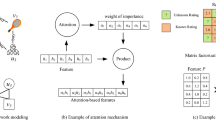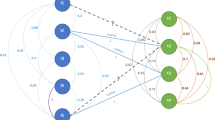Abstract
Based on the complex network, the relationship in the real complex system can be modeled, and the bipartite network is a special complex network, which can describe the complex system containing two kinds of objects. Although existing bipartite networks can model complex systems, conventional methods are restricted to a couple of limitations. (1) The dynamic interaction between nodes cannot be described over time. (2) The implicit features of nodes in the network cannot be effectively mined. Based on these, this paper proposes a dynamic bipartite network model (DBN) to model the dynamic interaction between two types of objects in real complex systems, and mine the structure features and preference features of nodes in the network. First, the dynamic interaction between two types of objects in a complex system is modeled as a dynamic bipartite network, which can reflect the interaction between objects in each time slice. Then, the structure features and preference features of each time slice are mined based on the dynamic bipartite network, where the structure features reflect the dynamic structural changes of the nodes, and the preference features reflect the potential preferences of the nodes. Finally, the features of each time slice are fused and input into the gate recurrent unit model to predict the interaction between nodes. Extensive experiments are performed on a large-scale real complex system. The results show that DBN significantly outperforms state-of-the-art prediction methods in terms of multiple evaluation metrics.






Similar content being viewed by others
Data availability
The dataset and code for this study can be found at https://github.com/lvhehe/DBN.
References
Klishin AA, Bassett DS (2022) Exposure theory for learning complex networks with random walks. J Complex Netw 486:75–174
Ghosh S, Miyoshi N, Shirai T (2022) Disordered complex networks: energy optimal lattices and persistent homology. IEEE Trans Inf Theory 68:5513–5534
Zhao J, Deng Y (2021) Complex network modeling of evidence theory. IEEE Trans Fuzzy Syst 29:3470–3480
Arthur R (2020) Modularity and projection of bipartite networks. Phys A Stat Mech Appl 549:124341
Guillaume J, Latapy M (2006) Bipartite graphs as models of complex networks. Phys A Stat Mech Appl 371(2):795–813
Li X, Zhang M, Wu S, Liu Z, Wang L, Philip SY (2020) Dynamic graph collaborative filtering. In: 2020 IEEE international conference on data mining (ICDM). IEEE, pp 322–331
Jiang S, Koch B, Sun Y (2021) Hints: citation time series prediction for new publications via dynamic heterogeneous information network embedding. In: Proceedings of the web conference 2021, pp 3158–3167
Fu H, Huang F, Liu X, Qiu Y, Zhang W (2022) MVGCN: data integration through multi-view graph convolutional network for predicting links in biomedical bipartite networks. Bioinformatics 38(2):426–434
Zhou C, Zhang J, Gao K, Li Q, Hu D, Sheng VS (2022) Bipartite network embedding with symmetric neighborhood convolution. Expert Syst Appl 198:116757
Gao M, He X, Chen L, Liu T, Zhang J, Zhou A (2020) Learning vertex representations for bipartite networks. IEEE Trans Knowl Data Eng 34:379–393
Ramalingeswara Rao T, Ghosh SK, Goswami A (2021) Mining user–user communities for a weighted bipartite network using spark GraphFrames and Flink Gelly. J Supercomput 77(6):5984–6035
Xia J, Wu F, Xiong Z, Qiu M, Xie C (2017) Modeling recommender systems via weighted bipartite network. Concurr. Comput. Pract. Exp. 29(14):3895
Pan L, Shao H, Mesbahi M, Xi Y, Li D (2018) Bipartite consensus on matrix-valued weighted networks. IEEE Trans. Circuits Syst. II Express Briefs 66(8):1441–1445
Noulapeu Ngaffo A, El Ayeb W, Choukair Z (2021) A time-aware service recommendation based on implicit trust relationships and enhanced user similarities. J Ambient Intell Humaniz Comput 12(2):3017–3035
Tong E, Niu W, Liu J (2021) A missing QoS prediction approach via time-aware collaborative filtering. IEEE Trans Serv Comput 15:3115–3128
Wu X, Fan Y, Zhang J, Lin H, Zhang J (2019) QF-RNN: QI-matrix factorization based RNN for time-aware service recommendation. In: 2019 IEEE international conference on services computing (SCC). IEEE, pp 202–209
Zhu J, He P, Xie Q, Zheng Z, Lyu MR (2017) Carp: context-aware reliability prediction of black-box web services. In: 2017 IEEE international conference on web services (ICWS). IEEE, pp 17–24
Meng S, Zhou Z, Huang T, Li D, Wang S, Fei F, Wang W, Dou W (2016) A temporal-aware hybrid collaborative recommendation method for cloud service. In: 2016 IEEE international conference on web services (ICWS). IEEE, pp 252–259
Luo X, Wu H, Yuan H, Zhou M (2019) Temporal pattern-aware QoS prediction via biased non-negative latent factorization of tensors. IEEE Trans Cybern 50(5):1798–1809
Berahmand K, Li Y, Xu Y (2023) DAC-HPP: deep attributed clustering with high-order proximity preserve. Neural Comput Appl 35(34):24493–24511
Berahmand K, Mohammadi M, Sheikhpour R, Li Y, Xu Y (2024) WSNMF: weighted symmetric nonnegative matrix factorization for attributed graph clustering. Neurocomputing 566:127041
Zhang J, Gao M, Yu J, Yang L, Wang Z, Xiong Q (2021) Path-based reasoning over heterogeneous networks for recommendation via bidirectional modeling. Neurocomputing 461:438–449
Yu Z, Huang F, Zhao X, Xiao W, Zhang W (2021) Predicting drug-disease associations through layer attention graph convolutional network. Brief Bioinform 22(4):243
Bai X, Zhang F, Li J, Xu Z, Patoli Z, Lee I (2021) Quantifying scientific collaboration impact by exploiting collaboration-citation network. Scientometrics 126(9):7993–8008
Wang W, Lv H, Zhao Y (2020) Predicting DNA binding protein-drug interactions based on network similarity. BMC Bioinform 21(1):1–13
Wang W, Lv H, Zhao Y, Liu D, Wang Y, Zhang Y (2020) DLS: a link prediction method based on network local structure for predicting drug–protein interactions. Front Bioeng Biotechnol 8:330
Lv H, Zhang B, Hu S, Xu Z (2022) Deep link-prediction based on the local structure of bipartite networks. Entropy 24(5):610
Xu S, Yang C, Shi C, Fang Y, Guo Y, Yang T, Zhang L, Hu M (2021) Topic-aware heterogeneous graph neural network for link prediction. In: Proceedings of the 30th ACM international conference on information and knowledge management, pp 2261–2270
Zou G, Chen J, He Q, Li K, Zhang B, Gan Y (2020) NDMF: neighborhood-integrated deep matrix factorization for service QoS prediction. IEEE Trans Network Serv Manag 17(4):2717–2730
Liang T, Chen M, Yin Y, Zhou L, Ying H (2021) Recurrent neural network based collaborative filtering for QoS prediction in IoV. IEEE Trans Intell Transp Syst 23(3):2400–2410
Yao K, Liang J, Liang J, Li M, Cao F (2022) Multi-view graph convolutional networks with attention mechanism. Artif Intell 307:103708
Wang X, Ji H, Shi C, Wang B, Ye Y, Cui P, Yu PS (2019) Heterogeneous graph attention network. In: The world wide web conference, pp 2022–2032
Du Y, Wang L, Peng Z, Guo W (2021) Review-based hierarchical attention cooperative neural networks for recommendation. Neurocomputing 447:38–47
Zheng Z, Zhang Y, Lyu MR (2010) Distributed QoS evaluation for real-world web services. In: 2010 IEEE international conference on web services. IEEE, pp 83–90
Silic M, Delac G, Srbljic S (2014) Prediction of atomic web services reliability for QoS-aware recommendation. IEEE Trans Serv Comput 8(3):425–438
Li S, Wen J, Luo F, Ranzi G (2018) Time-aware QoS prediction for cloud service recommendation based on matrix factorization. IEEE Access 6:77716–77724
Xiong R, Wang J, Li Z, Li B, Hung PC (2018) Personalized LSTM based matrix factorization for online QoS prediction. In: 2018 IEEE international conference on web services (ICWS). IEEE, pp 34–41
Zhang Y, Yin C, Lu Z, Yan D, Qiu M, Tang Q (2019) Recurrent tensor factorization for time-aware service recommendation. Appl Soft Comput 85:105762
Fayala M, Mezni H (2020) Web service recommendation based on time-aware users clustering and multi-valued QoS prediction. Concurr Comput Pract Exp 32(9):5603
Zou G, Li T, Jiang M, Hu S, Cao C, Zhang B, Gan Y, Chen Y (2022) Deeptsqp: temporal-aware service QoS prediction via deep neural network and feature integration. Knowl-Based Syst 241:108062
Acknowledgements
Not applicable.
Funding
The author acknowledges the support provided by the Natural Science Foundation of Xinjiang Uygur Autonomous Region (NoN2022D01A236).
Author information
Authors and Affiliations
Contributions
HL proposed the research plan, coding, and writing of this paper. GZ and BZ supervised the projects. SH, CZ, and LW were in charge of data collection and analysis, translation, and discussion. All authors contributed to the article and approved the submitted version.
Corresponding author
Ethics declarations
Conflict of interest
The authors declare that they have no known competing financial interests or personal relationships that could have appeared to influence the work reported in this paper.
Ethical approval
Not applicable as this study did not involve human participants.
Additional information
Publisher's Note
Springer Nature remains neutral with regard to jurisdictional claims in published maps and institutional affiliations.
Rights and permissions
Springer Nature or its licensor (e.g. a society or other partner) holds exclusive rights to this article under a publishing agreement with the author(s) or other rightsholder(s); author self-archiving of the accepted manuscript version of this article is solely governed by the terms of such publishing agreement and applicable law.
About this article
Cite this article
Lv, H., Zou, G., Zhang, B. et al. Dynamic bipartite network model based on structure and preference features. Knowl Inf Syst (2024). https://doi.org/10.1007/s10115-024-02093-8
Received:
Revised:
Accepted:
Published:
DOI: https://doi.org/10.1007/s10115-024-02093-8




